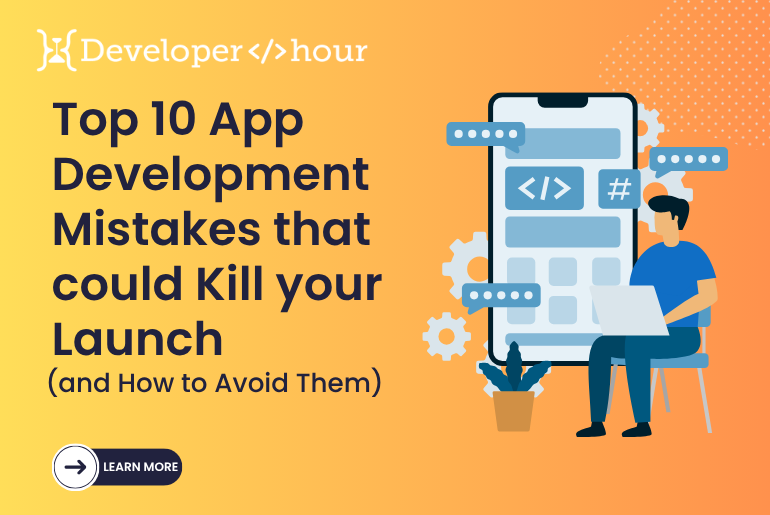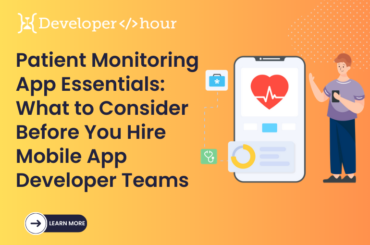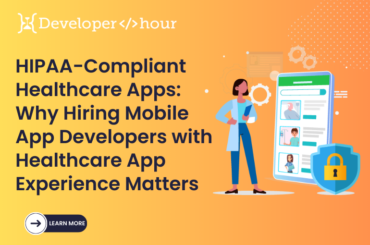You have spent several months (or maybe years) developing your mobile app – improving its core features, adjusting the UI, and testing the overall user experience. The big day for your app’s release has come, but rather than a great vibe, you get a void. Downloads have stopped, bugs are appearing here and there, and reviews are getting worse and worse.
Is it sounding familiar? Well, you are not the only one who has happened to. Even the most start-ups that have the most creative ideas and funding might go down an app launch failure – not due to their bad concepts but because of taking the wrong steps (in planning, designing, or implementation).
In today’s cutthroat app world, just one fault can wipe out the work done for several months. Thus, if you are a startup, an agency, or an enterprise, then this manual will assist you in recognizing those ten app development faux pas that could wreck your launch – besides that, the hints on how to escape from them.
Top 10 App Development Mistakes That Can Kill Your Launch
1. Skipping the Market Research Phase
The developers’ number one error is the assumption that they have a clear picture of their audience without actually doing the market research. The risk without good market research is to create an app that solves the wrong problem – or to solve the right problem for the wrong people.
Why it matters:
Market research is the key to understanding your users’ problems, their spending habits, and what they expect. If you don’t do it you will end up being positioned incorrectly in the market and spending your money on things that don’t help you.
How to avoid it:
- Perform a comparative study to realize what user requirements are already fulfilled.
- Tools such as Google Trends, App Annie, and SurveyMonkey can be used to confirm expected demand.
- Early talks with potential users help to clarify your unique selling proposition.
Pro Tip: Even if you feel that your idea is so special, you should first find some supporting data and only then start coding.
2. Building Too Many Features at Once
One tries to stuff an app with every feature that the team can dream of. Nevertheless, overbuilding results in being too complicated, users getting lost, and slowing down the whole process.
Why it matters:
The size of features directly influences pricing, with longer development times, and gives more opportunities for glitches. Therefore, users tend to want a simple app that will perform their one main function very quickly and well.
How to avoid it:
- Develop an MVP (Minimum Viable Product) first.
- Use a feature prioritization method like MoSCoW (Must-have, Should-have, Could-have, Won’t-have) to decide what features to add first.
- Gather feedback post-launch and diversify gradually.
Remember: Fantastic apps change over time. They are not released with all the latest features – they expand according to user needs.
3. Ignoring the UX/UI Design Process
An app that works great but has a bad UX will still lose out. Confusing navigation, jam-packed pages, and disorganized sections infuriate users – and they won’t return.
Why it matters:
The font and colors (UX) decide whether the user will be engaged and will come back again. First impressions are very important – 94% of users decide an app’s trustworthiness by the quality of its design.
How to avoid it:
- Start UX research in advance of the building stage.
- Use platform-specific style deeply (Material Design for Android, Human Interface Guidelines for iOS).
- Do real-user testing with the prototypes before you decide on the last one.
Pro Tip: Never compromise between beauty and convenience — the prettiest skin becomes useless if users keep losing their way.
4. Overlooking Quality Assurance (QA) Testing
Skipping or rushing testing will kill you if you are trying to launch an app. The bugs, crashes, and performance issues will instantaneously take away any credit that you already got.
Why it matters:
An app full of instability leads to users getting rid of it, negative feedback, and a low ranking in the app store.
How to avoid it:
- You should do continuous testing for the whole development cycle.
- Try the app on multiple devices as well as different OS versions and network speeds.
- Actually, allow beta users to use the app to get your usability testing in the real world.
Pro Tip: Put your money into automated testing tools (e.g., Appium or XCTest) — the running of regression tests is made faster, thereby giving more time for the launch.
5. Neglecting Security and Data Protection
In 2025, users are more aware — and less forgiving — of security flaws. Apps that mishandle personal data or suffer breaches lose trust overnight.
Why it matters:
Security breaches can cause the brand to be sued, harmed, and lose its users forever.
How to avoid it:
- Encipher data and use strong authentication.
- Follow GDPR and CCPA compliance (especially for U.S. users).
- Conduct penetration testing before launch.
Pro Tip: Don’t save user data in a vulnerable format. Make use of secure APIs and tokenization.
6. Not Optimizing App Performance
Slow and laggy apps are the fastest way to kill user experience.
Why it matters:
A 2-second waiting time can lead to a decrease of user retention of 20%. Speed has a direct relation with user engagement, conversion, and app-store rating.
How to avoid it:
- Reduce the size of images and other content.
- Make APIs and network calls more efficient.
- Incorporate lazy loading and on-device caching.
- Do an in-depth analysis and performance testing by using Firebase Performance and Android Profiler.
If you are still interested, check the cold start of your app — the quicker your first screen is loaded, the higher the retention.
7. Misjudging Budget and Timelines
Timed, rushed, and Unrealistic Budgets can kill your app quality silently. Startups are especially likely to succumb to this trap if they attempt to launch the product a few times too soon.
Why it matters:
Cutting short on the design, testing, or backend will bring you back to the same place, but this time you will have to pay more for the redo.
How to avoid it:
- Have a scope document and timeline milestones for it.
- Include 15–20% extra time for unpredictable delays.
- Make sure you hire the best mobile app development company for quality, not speedy delivery.
Pro Tip: Don’t think of development as an expense; instead, treat it as an investment, and you will see the value of what you put in.
8. Failing to Prepare for Different Devices and Platforms
Your app needs to work perfectly on Android, iOS, and all different screen sizes. Too many developers just test their app on the most expensive phones — that is a huge mistake.
Why it matters:
Fragmentation is harsh. Without optimizing for different devices, you will have a limited number of people using your product because of an unwelcoming user experience.
How to avoid it:
- Test on multiple screen resolutions and operating systems.
- Use responsive layouts and adaptive UI components.
- Consider cross-platform frameworks like Flutter or React Native for consistency.
Pro Tip: Always test on both low-end and high-end devices — not everyone has a flagship phone.
9. Launching Without a Marketing Strategy
An app with no marketing will never go viral, no matter how perfect it is. Farewell with a no-pre-launch marketing plan is a big ‘no’.
Why it matters:
There are a lot of apps on the market and new ones are released daily, so without being seen, your fishation will be doomed very quickly.
How to avoid it:
- Start hype building weeks ahead of launch (social media, press releases, landing pages).
- App Store Optimization (ASO) can be your tool to get higher visibility.
- Collecting beta reviews early is about trust and momentum.
Pro Tip: See your app launch as a movie premiere — teasers, trailers, and hype are what make it all matter.
10. Ignoring Post-Launch Support and Analytics
Your mission does not terminate at launch — rather, it starts there. The majority of developers are fast at forgetting about updates, bug fixes, and user feedback loops.
Why it matters:
Non-maintained apps lose their fans very fast and also go down in rankings.
How to avoid it:
- Employ tools like Firebase Analytics or Mixpanel for monitoring.
- Keep that periodic release of updates coming to solve issues and enhance UX.
- Be sure to regularly check user retention, crash, and engagement data.
Pro Tip: Releasing is only the first step — success that is long-lasting depends on iteration and taking user feedback into account.
Final Thoughts
It is not luck that makes an app successful — rather, it is the hard work done beforehand. By sidestepping these 10 prevalent app development errors can be the deciding factor if your app goes down the drain or thrives.
In the case of startups, it boils down to focus. Enterprises benefit from being consistent, whereas agencies gain from being reliable. However, the point is the same for everyone — to provide an app that is fast, stable, and loved by users.
The team at Developer Per Hour is here to make your app the one that has success from day one. We are with you from MVP designing through post-launch optimization. Our specialists turn app failures into app triumphs and make your app perform exceptionally.
Ready to launch your app the right way?
Join forces with Developer Per Hour, your reliable mobile app development company, and morph your app concept into a smooth, high-performing, and impeccable reality.




